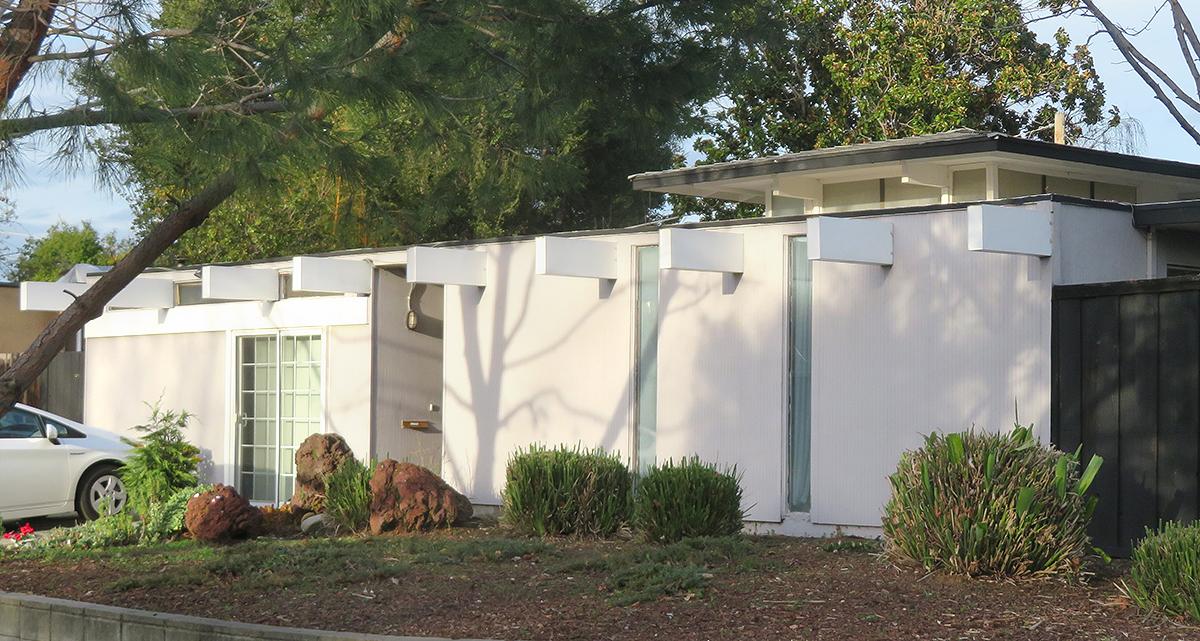
Is Your Modern Neighborhood Historic?
 |
Three years ago, when the Eichler neighborhood of Fairglen, in San Jose, was placed on the National Register of Historic Places, several people who love Eichlers were taken aback by some of the homes in the tract that were deemed to 'contribute' to the historic integrity of the neighborhood.
Wait a minute here. Some of these contributing structures have second-story additions! Some have suffered other changes that violate the pure Eichler aesthetic. What is going on here?
No one argued that the Fairglen Eichlers were undeserving of the honor, one of the highest a neighborhood can receive. Fairglen would have qualified even without counting the houses that had been altered.
And we don’t want to encourage homeowners to add second stories, or suggest that such modifications don’t harm architectural integrity. They do; and second stories also raise issues of privacy for neighbors, of course.
 |
In an effort to encourage more Eichler and Streng homeowners to place their neighborhoods on the Register, the Eichler Network is running a series of articles based on an interview with Jay Correia, a state historian who helps people place buildings and neighborhoods on the Register, to clarify the procedure.
As our earlier piece pointed out, there are now four Eichler tracts on the Register: two in Palo Alto, one in San Jose, and another in Santa Clara.
What we learn from Correia is that the process can be exacting, as applicants must show not just that their neighborhood is beautiful but that it has historic value – and must explain what gives it that value.
But the process is also forgiving, particularly, Correia says, when it comes to judging architectural integrity. Has your roof been altered? Windows too? The alterations may not prevent your home from helping establish the historic value of the neighborhood.
Thinking about applying for a neighborhood historic district in the National Register? Drive through your neighborhood and consider, Correia suggests.
 |
“Does it feel like a neighborhood that was built in the 1950s,” he says, “looking around without closely analyzing every single contributor? Does this feel like a Joseph Eichler neighborhood?”
When Correia first started working at the California Office of Historic Preservation, which sends proposed Register properties to the National Park Service for final placement, integrity “was just such a hot-button issue,” he says. “I think that that’s going away somewhat.”
“Specifically, an Eichler home that has had a second story added, that does not automatically mean that it doesn’t contribute to the neighborhood.”
The term preservationists use is “additive,” he says. Such additions may annoy purists, but they may not destroy all historical integrity, according to Correia.
“So adding parts to a building, the original bones are still there. The original property still exists.”
 |
“I mean, obviously, the integrity of design has been compromised by this second story. But the house probably still has the same setback from the street. It’s probably no wider than it once was,” he says.
“Can you tell that it’s an Eichler with a second story? You know, just that fact, I would argue, makes it still a contributor. If it looks like some other type of house with a second story, I would argue [not].”
“Don’t forget that a historic district can be comprised wholly of properties that would not be eligible on their own.” It is the district that is deemed historic, he says, not any of the individual homes.
When the first two Eichler neighborhoods to make the National Register were surveyed by the Historic Quest committee that wrote the nominations, between 2000 and 2005, the written criteria the committee adopted and applied were far more rigorous than what is used today.
Historic Quest developed a checklist on such topics as integrity of rooflines, front elevation and trim, and doors and windows. Changes to the original house were assigned minus points by the committee as it walked through and surveyed each neighborhood. Any house that got dinged for 12 points or more was deemed a non-contributing structure. An added second story alone carried with it 12 minus points.
Today, Correia says, "There is no check-off list, or percentage of total historic fabric or features, by which contributing resources are measured."
"Two of the seven aspects of historic integrity are feeling and association," Correia says, adding. "It is not purely about pieces and parts."
To place a neighborhood on the National Register, applicants must list and describe every house. This aspect of the process has toughened over the years. Correia describes National Register nominations he has read from the 1970s that were far less detailed than those today, and therefore are less useful, for example, if proposals arise to make changes or demolitions to properties within a district.
 |
“It could open the door to say, ‘Hey, it’s not even significant. I want to tear mine down,’” Correia says.
“One of the first requirements is we need a section that tells us about every house, what year it was built,” he says, information on what model each house is, and the like.
Correia recounts the history of the National Register, which was established by the National Historic Preservation Act of 1966 as a reaction against the wholesale destruction of urban neighborhoods through slum clearance.
Being placed on the Register does not provide any legal protections against demolitions or other changes – but it does alert local officials that designated properties are historically important, and leaves it to the locals to decide how to proceed.
In recent years, Correia says, the focus of the Register has grown beyond merely preserving buildings, but to consider the impact buildings have on neighborhoods. Anyone who lives in a typical, tightly knit Eichler or Streng community can understand that.
“Preservations have moved away from just the built environment, and it’s become more about sustaining communities that those built environments facilitate.”
- ‹ previous
- 349 of 677
- next ›



